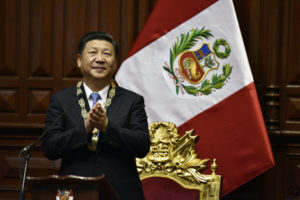Andrés Serbin – China, Latin America, and the New Globalization

Chinese President Xi Jinping received a medal of honor from the Peruvian Congress during his tour of South America last month, which included the Asian-Pacific Economic Cooperation summit in Lima. / Ministerio de Relaciones Exteriores, Peru / Flickr / Creative Commons
Published in AULA Blog: https://aulablog.net/2016/12/13/china-latin-america-and-the-new-globalization/
In Latin America and elsewhere, the world is undergoing tectonic movements that indicate the birth of a new world order with new rules of play. For much of the past decade, dynamism in world commerce and finance has been shifting from the Atlantic basin to the Pacific. While the international economy has shown fragility and the developed economies – particularly the European Union and the United States – have shown slow growth since the crisis of 2008, China and the emerging economies of the Asian-Pacific region have experienced sustained growth. China, now the second biggest economy in the world, has been the driver of that growth and, according to most projections, is poised to overtake the United States as the biggest. After several centuries in which power has been concentrated in the West, the emergence of new powers in a multi-polar world will naturally bring about changes in the norms and rules governing the international agenda.
In Latin America and other regions, there is growing awareness of this process – with China and its own version of globalization at its center. The region has witnessed the paralysis of the Transatlantic Trade and Investment Partnership (TTIP) between the EU and the United States as well as U.S. President-elect Donald Trump’s declaration that he will withdraw the United States from the Trans-Pacific Partnership (TPP) as part of a broader anti-globalization policy. Trump’s announcement drew two different reactions from participants from TPP country leaders at the Asian-Pacific Economic Cooperation summit in Lima late last month. One was the express decision to proceed with TPP even without the United States, and the other was a clear receptivity to Chinese President Xi Jinping’s invitation that they join regional economic groups that he is pushing – the Regional Comprehensive Economic Partnership (RCEP) and the Free Trade Area of the Asia-Pacific (FTAAP).
- Both agreements explicitly exclude the United States and abandon norms customarily pushed in free trade by the West. They emphasize reducing tariffs and give no consideration to labor and environmental regulations and non-tariff measures.
- They complement China’s “one belt, one road” initiative, a modern-day revitalization of the Silk Road creating trade links between China’s western regions with Russia, Central Asia, and eventually to Europe, developing land and maritime routes along the way. The Shanghai Cooperation Organization (SCO) – an economic and security pact linking China, Russia, four Central Asian nations, and now welcoming India and Pakistan – is explicitly linked to RCEP.
Washington’s pending rejection of TPP eliminates a central part of President Obama’s “pivot” strategy to counter China’s rapidly expanding influence in Southeast Asia and the South China Sea, but it also has implications for Latin America and the Caribbean as China moves in rapidly to fill the void left by U.S. withdrawal. While President-elect Trump has pledged to “renegotiate” NAFTA – which he called “probably the worst trade deal ever agreed to in the history of the world” – China last month presented to Latin America a detailed document proposing a new era in relations with “comprehensive cooperation” in all areas and reaffirming a “strategic association” with the region. In sharp contrast with the new U.S. President’s views of Latin America, Beijing calls Latin America and the Caribbean “a land full of vitality and hope,” praises the region’s “major role in safeguarding world peace and development,” and calls it “a rising force in the global landscape.” While some analysts suggest that globalization is slowing if not ending, these developments more strongly indicate that it is rather taking on a new form within a new world order that clashes with the visions and values of the West. We appear to be transitioning into a world that is genuinely multi-polar with globalization under new rules.
December 13, 2016
* Andrés Serbin is the president of the Coordinadora Regional de Investigaciones Económicas y Sociales (CRIES), a Latin American think tank. This article is adapted from an essay in Perfil, based in Buenos Aires.
